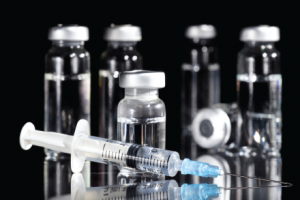
Nikolay Litov / shutterstock.com
For patients with hip osteoarthritis (OA), pain management and maintaining function are primary therapy goals. Current guidelines offer recommendations on nonpharmacologic and pharmacologic approaches to addressing these issues in hip OA.
For patients in whom pharmacologic management is considered, the use of intra-articular steroid injections is one option. In its 2012 guidelines (the most current available) the ACR gave the use of intra-articular corticosteroid injections a conditional recommendation for the initial management of OA.1 Evidence in support of that recommendation was based largely on data extrapolated from studies that looked at the use of steroid injections for knee OA.
In a study published in 2016, McCabe and colleagues conducted a literature review of the evidence for the use of intra-articular steroids for hip OA.2 Based on five studies, the investigators found that steroid injections in hip OA may be efficacious in the short term to reduce pain. However, they emphasized again that the evidence on which this outcome is based remains relatively poor and called for larger, rigorous trials to verify the true efficacy of steroid injections for hip OA.
Into this dearth of evidence on the true efficacy of steroid injections for hip OA comes a study cautioning that such injections may actually be deleterious and may spur osteonecrosis and bone collapse.
Connie Y. Chang, MD, a radiologist at Massachusetts General Hospital and assistant professor of radiology at Harvard Medical School, Boston, presented results of the study in November 2017 at the Radiological Society of North America (RSNA) Annual Meeting.3
Bone Death & Collapse
The study included three groups of patients: 102 patients with hip OA treated by steroid injections (intervention group) who underwent radiologic imaging of the hip at the time of injection; 102 patients with hip OA who underwent radiologic imaging but were not treated by steroid injections (control group); and 44 patients who underwent imaging and were treated by steroid injections in the shoulder (control group). All patients underwent a second imaging at three–nine months’ follow-up. Patients in the control groups matched the demographics of those in the intervention group, which included 62 women ranging in age from 19–92 years.

Connie Y. Chang, MD, and research team
To assess whether steroid injections for hip OA would worsen osteoarthritis, two musculoskeletal radiologists independently performed a retrospective blinded review of the radiographs taken before and after the steroid injections in the patients in the intervention group, as well as of the radiographs of the two control groups.
Based on the two radiologists’ reports, the study found that 22–24% of patients with hip OA who received steroid injections showed new osteonecrosis compared with 9% of patients in the hip control group and 5% in the control group of patients who received shoulder steroid injections.3
In specific, the radiologists found bone collapse in the head of the femur bone in 15–17% of the patients in the intervention group compared with 4% in the hip control group and 2% in the control group of patients who received shoulder steroid injections.3
Commenting in a press release, Dr. Chang noted the rapid changes in bone in the intervention group. “Changes due to osteoarthritis, such as narrowing in the space between joints and the developments of bony proliferations, typically develop slowly over time. When reading follow-up radiographs of patients who had received a hip injection, we noticed changes had developed rapidly in some patients.”4
Caution Warranted: More Data Needed
Saying the study provides noteworthy observations about the potential effects of steroid injections in the hip, Sharon L. Kolasinski, MD, professor of clinical medicine, Division of Rheumatology, Penn Musculoskeletal Center, Perelman School of Medicine, University of Pennsylvania, emphasizes that more information is needed to understand which patients may be at risk for the deleterious effects noted in the study.
“We need to know exactly who the population is that is at risk and how big that risk is,” she says.

Dr. Kolasinski
Dr. Kolasinski emphasizes that the study offers an important observation that has not been made in previous studies. “There hasn’t been a previous study that looked at radiographic change following hip injection,” she says. “If you don’t look for it, you may miss it.”
Of note, she says, were the rapid changes to bone in the hip patients who received the injections. “It is really eye [opening] to see the percentages of patients with radiographic progression over a relatively short period of time following these injections,” she says. “Further, the percentage of patients experiencing osteonecrosis or new collapse is quite remarkable.”
In her comments in the press release, Dr. Chang noted that the patients with hip OA who received the steroid injections had disease that was severe enough to warrant the injections and therefore, compared with the control groups, were prone to faster progression of bony changes.
“We need to look at what’s going on with the steroid/anesthetic injectate and osteoarthritis patients to determine what’s causing the changes that occur in some patients,” she says in the press release.4
That said, Dr. Chang cautions that the study results should not be interpreted as negating the usefulness of steroid injections for some patients.
“However, we don’t want to deter patients from getting an injection,” she said in the press release. “These results are enough to warrant an investigation, not enough to cancel a procedure.”
To date, the study has not been published. [Author’s note: Attempts to obtain further comment from the study authors or information on the publication status were unsuccessful.]
Further information for clinicians on the appropriate use of hip steroid injections may be forthcoming in updated guidelines currently under development by the ACR and the Arthritis Foundation for the pharmacologic and nonpharmacologic management of osteoarthritis of the hand, hip and knee. Dr. Kolasinski, who is the principal investigator working on the guideline, says that a final published guideline is expected in early 2019.
Mary Beth Nierengarten is a freelance medical journalist based in Minneapolis.
References
- Hochberg MC, Altman RD, April KT, et al. American College of Rheumatology 2012 recommendations for the use of nonpharmacologic and pharmacologic therapies in osteoarthritis of the hand, hip, and knee. Arthritis Care Res (Hoboken). 2012 Apr;64(4):465–474.
- McCabe PS, Maricar N, Parkes MJ, et al. The efficacy of intra-articular steroids in hip osteoarthritis: A systematic review. Osteoarthritis Cartilage. 2016 Sep;24(9):1509–1517.
- Chang CY, Simeone FJ, Vicentini JRT, Kattapuram SV. Hip steroid/anesthetic injections: Is there an increased incidence of hip osteoarthritis progression, femoral head osteonecrosis and collapse? Radiological Society of North America Meeting Abstract. 2017.
- Radiological Society of North America. Press Release. Hip steroid injections associated with bone changes. 2017 Nov 29.